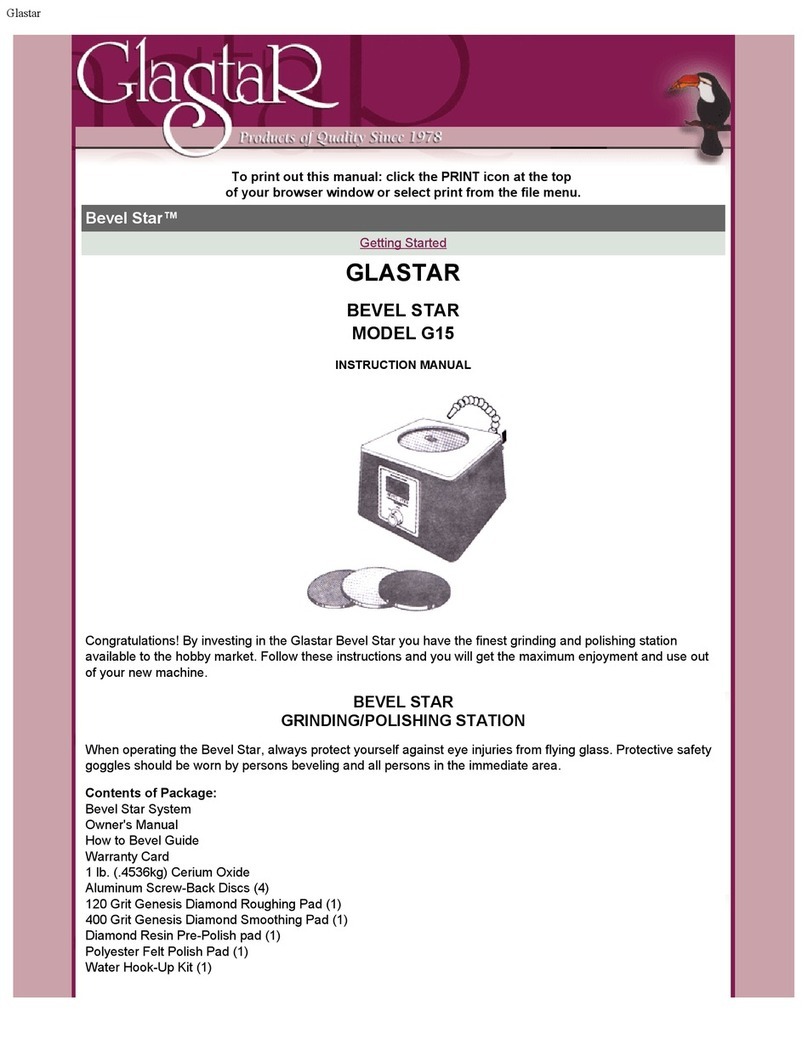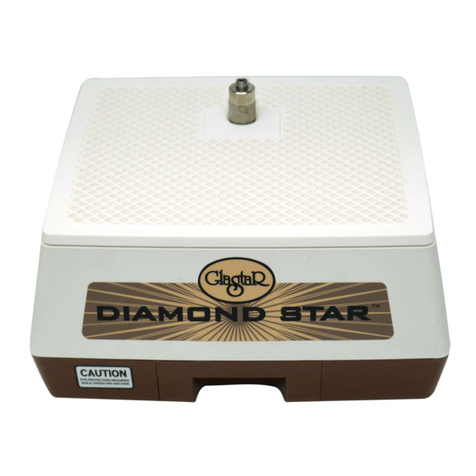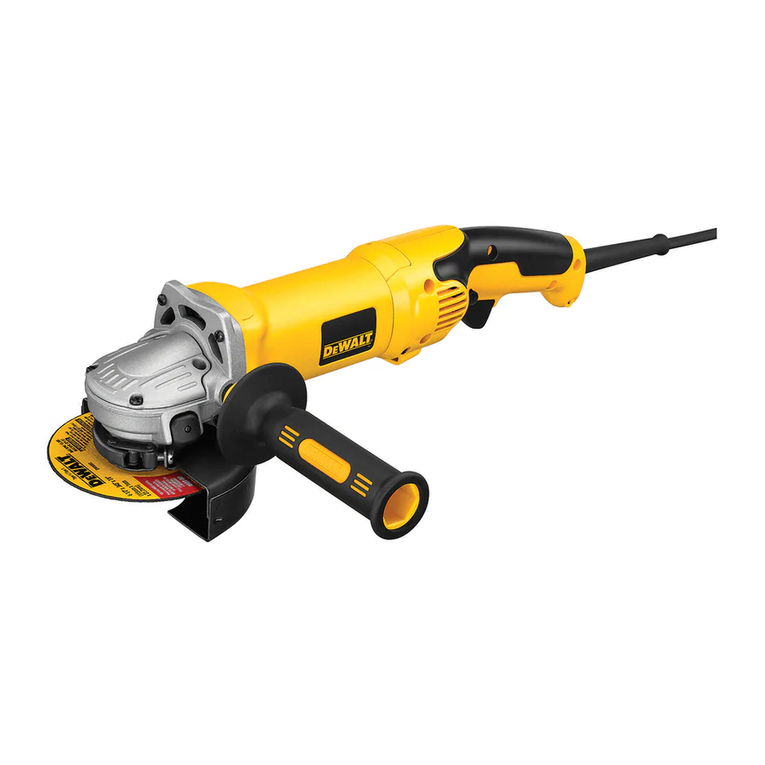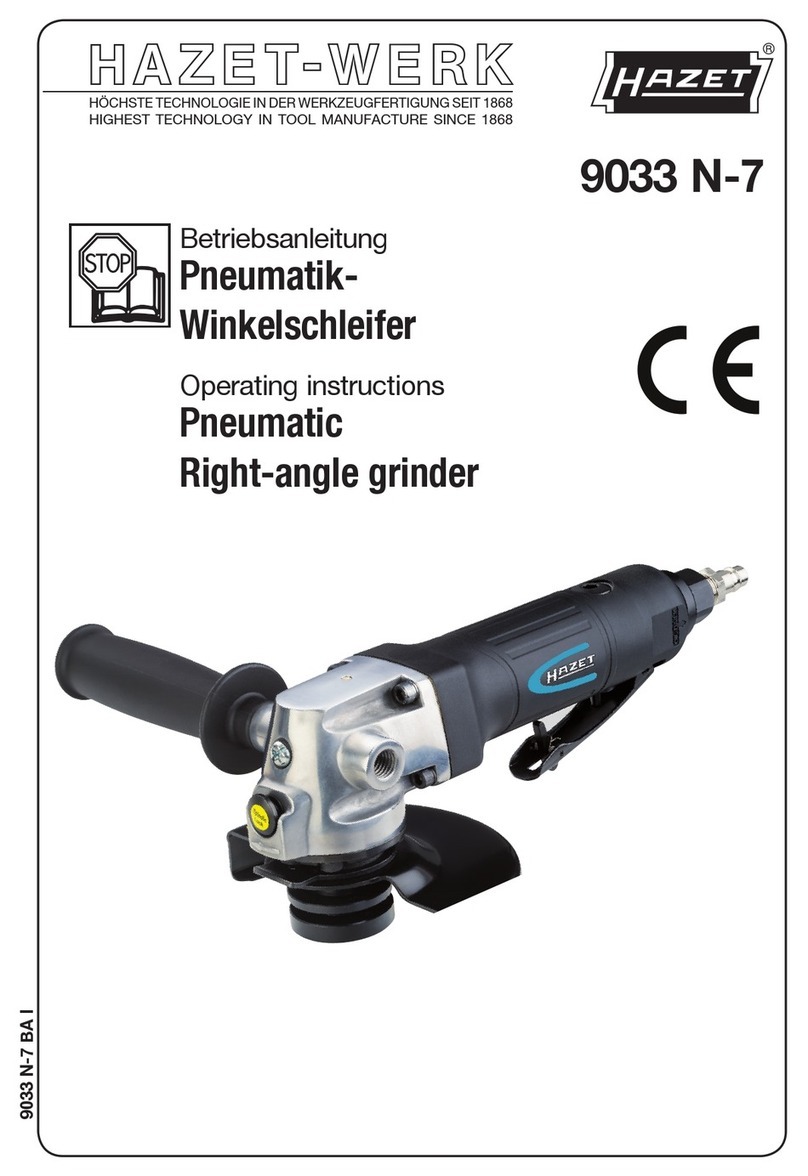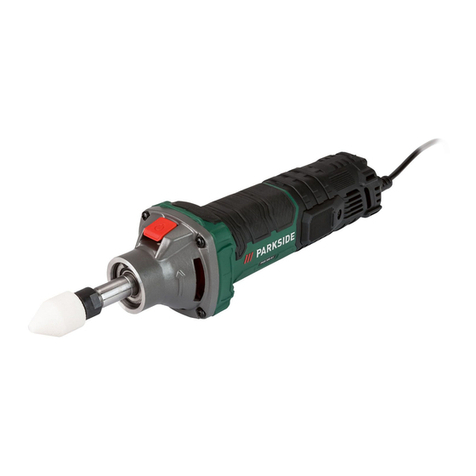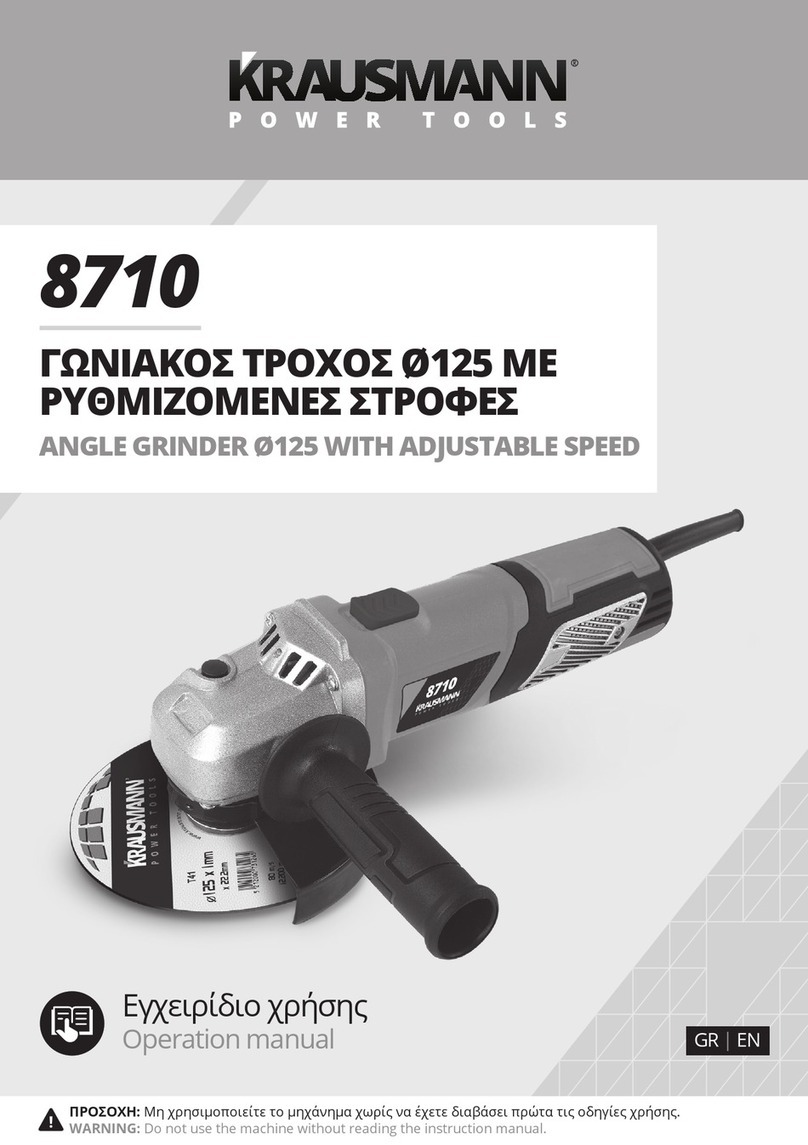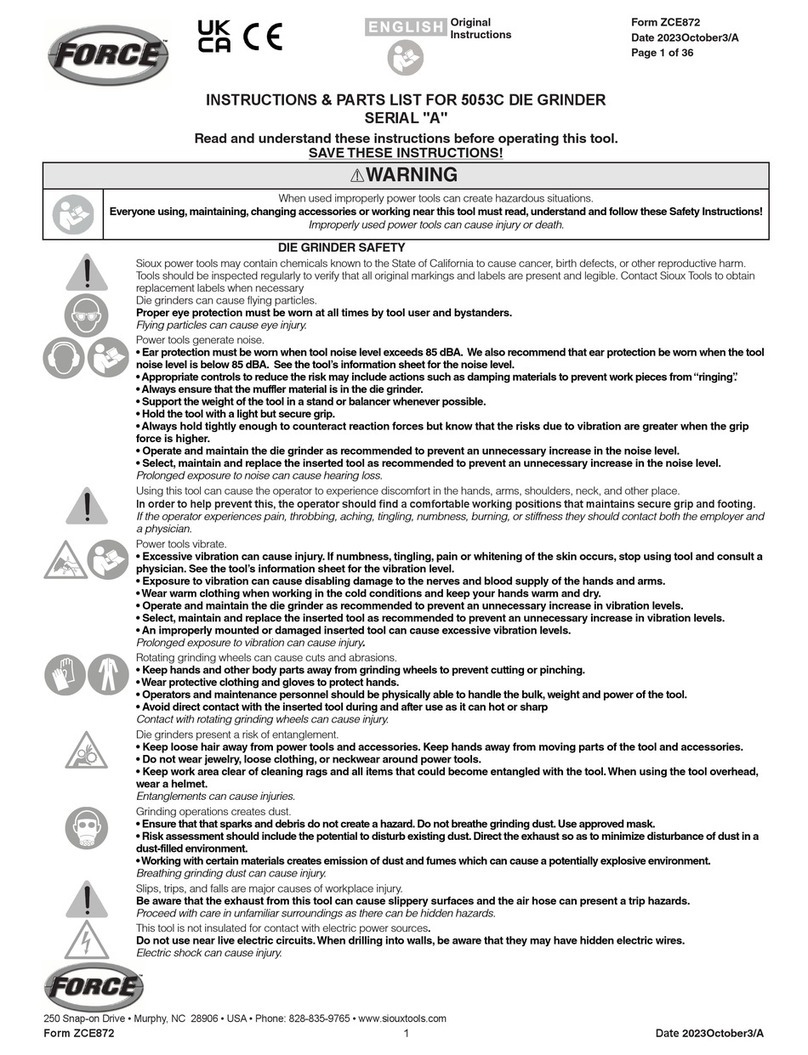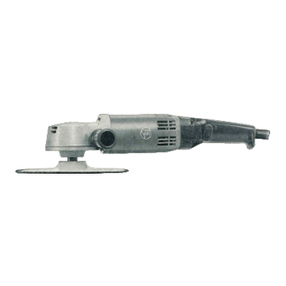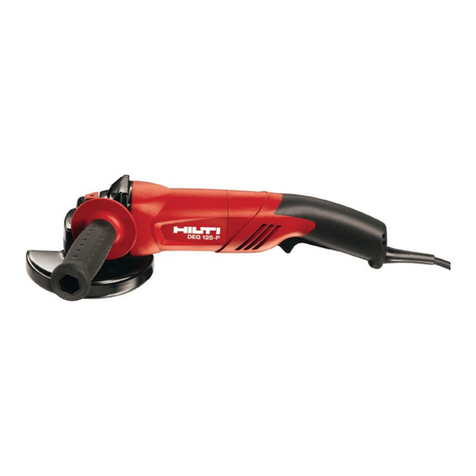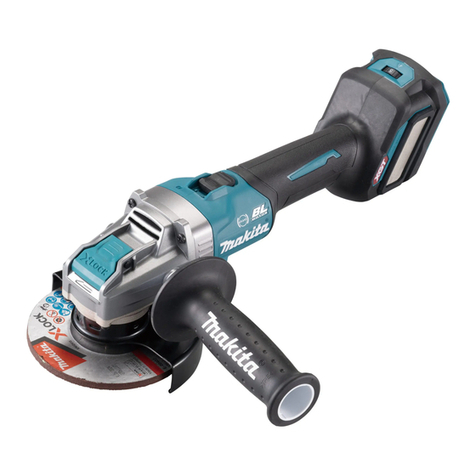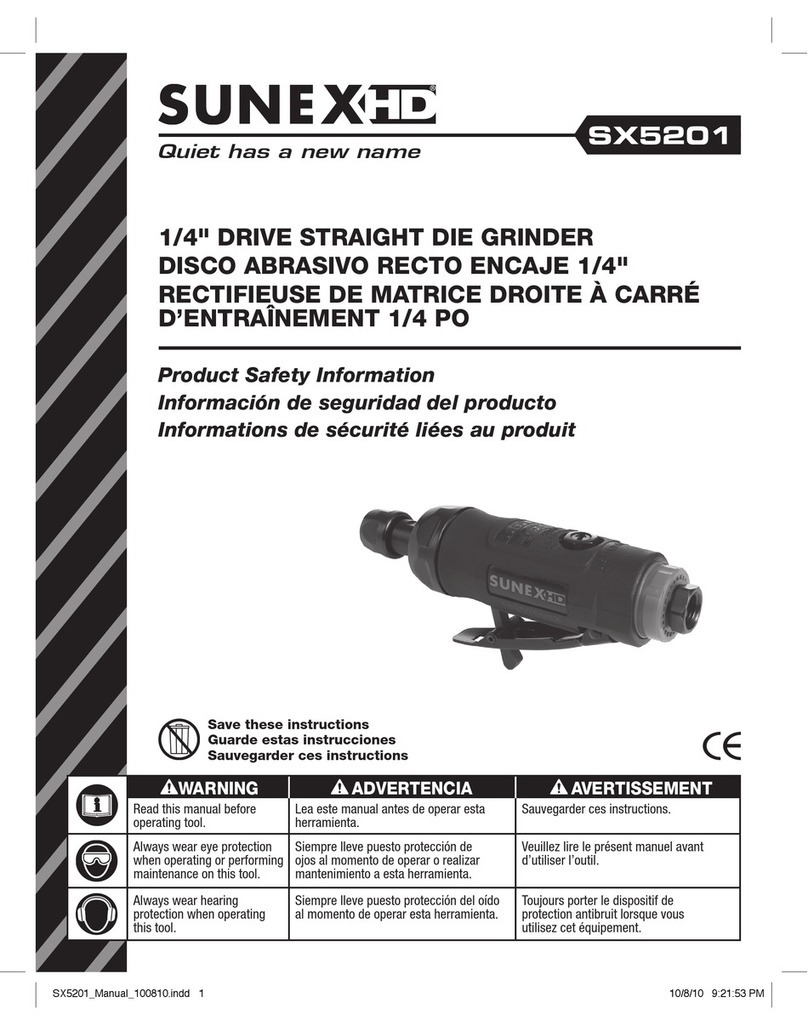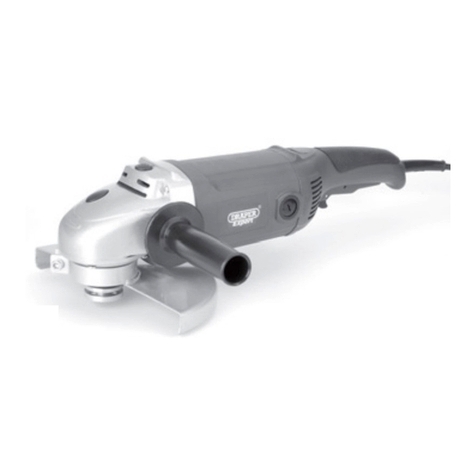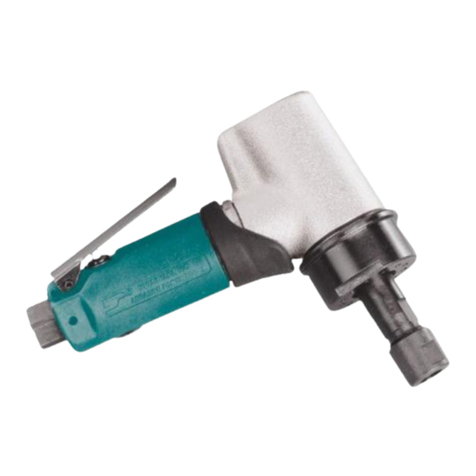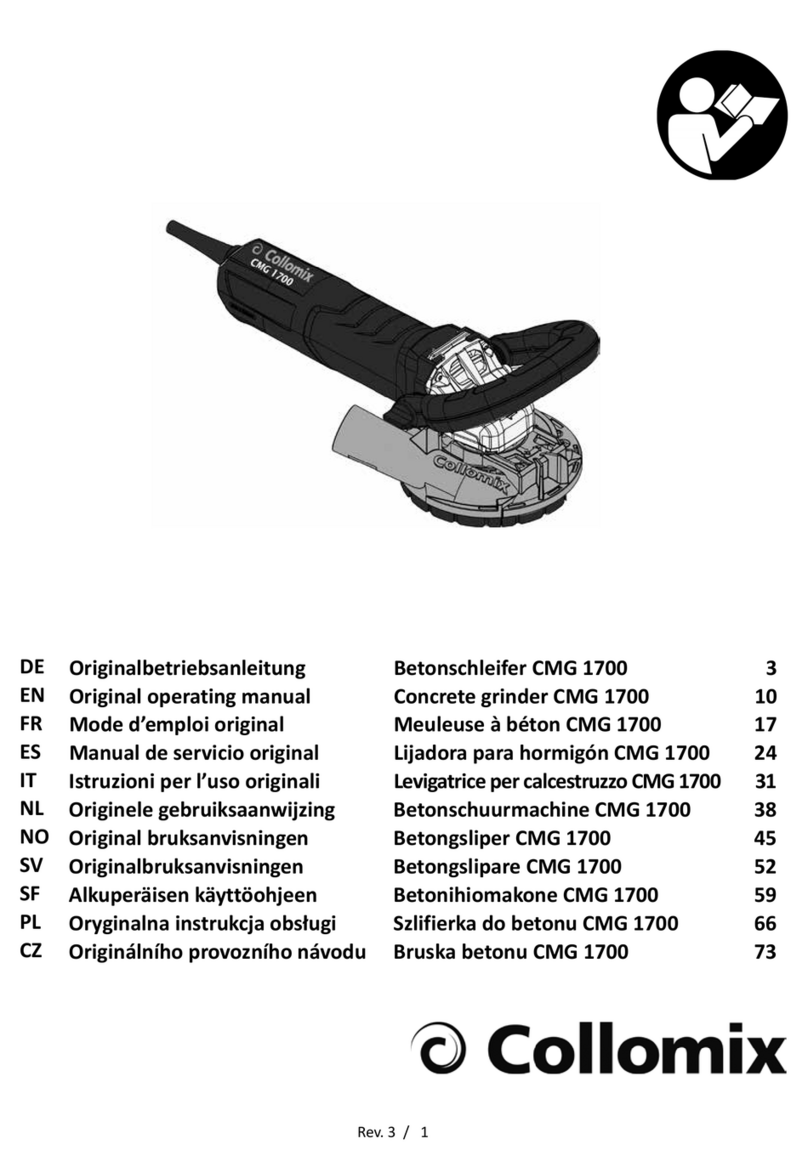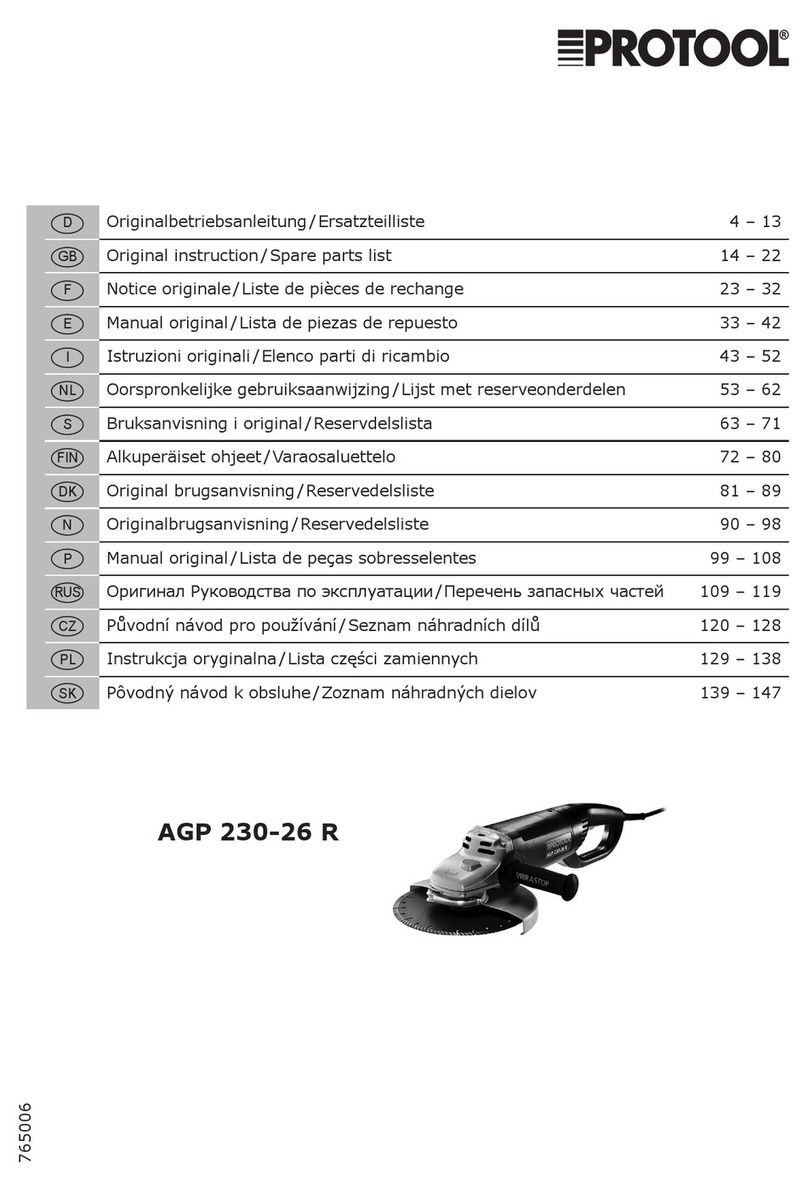Glastar All-Star G-8 User manual

Glastar
To print out this manual: click the PRINT icon at the top
of your browser window or select print from the file menu.
G-8 All-Star Grinder
ALL-STAR GRINDER
G-8 MANUAL
IMPORTANT SAFETY INSTRUCTIONS
READ ALL INSTRUCTIONS
FOR PERSONAL SAFETY THIS MACHINE MUST BE PROPERLY GROUNDED
The power cord of this machine is equipped with a three-prong (grounding) plug which mates with a standard
three-prong (grounding) wall receptacle to minimize the possibility of electric shock hazard. Where a standard
two-prong wall receptacle is encountered, it is the personal responsibility and obligation of the customer to have
it replaced with a properly grounded three-prong wall receptacle. DO NOT, UNDER ANY CIRCUMSTANCES,
CUT OR REMOVE THE THIRD (GROUNDING) PRONG FROM THE POWER CORD.
Always unplug your machine before cleaning or making any repairs-(NOTE: We strongly recommend that you
return the unit to the factory for repair.) USE ONLY IDENTICAL REPLACEMENT PARTS TO REPAIR THIS
MACHINE.
SAVE THESE INSTRUCTIONS
OUTSIDE USA (818) 341-0301 · INSIDE USA (800) 423-5635
FAX (818) 998-2078 · WEBSITE www.glastar.com
EMAIL: [email protected]
EYE PROTECTION
When operating the grinder, always protect yourself against eye injuries
from flying glass. Install the glass eye shield that is furnished with this

machine (see instructions below). The eye shield is preferable to glasses
because it eliminates glass chips flying toward the face.
VENTILATION
Openings in the grinder back and bottom are provided for ventilation. To insure reliable operation and
to protect the grinder from overheating, these openings must not be blocked or covered. Do not place
grinder near or over a radiator or heating vent. If this unit is installed within another enclosure, be sure
that adequate ventilation has been provided.
TOP of page
CONTENTS OF PACKAGE
1. Owners manual
2. Warranty card (please mail
this back right away)
3. Basic grinder, including:
A. Water Pump
B. Top plate
C. 1' (25.4mm) grinding head
4. Flexible drain stopper
5. Flexible splash guard
6. One-inch sponge and one spare
7. Allen key
8. Brass alignment collar
9. 1/4' (6.35mm) grinding head
10. Eye shield:
a. Stanchion
b. 8' x 9' (20.32 com x 22.86 cm)
piece of double strength glass
c. Two #12 x 3/4' (5.2 mm x 19.05 mm)
screws & washers
11. Mini table
12. Straight edge guide
a. Body
b. Five nylon rollers
c. Two #12 x 1' (5.2 mm x 25.4 mm) screws
& two washers
ASSEMBLY
1. Remove the top plate (main work surface) by lifting straight up at
each of the corners in turn.
2. Install the flexible stopper in the drain hole located in the left front
corner of the water basin. Make certain it is pushed in hard.
3. Replace the top plate and push straight down on it at the corners
to snap it back in place.
4. Install the flexible splash guard on the peg directly behind the
grinding ring.
5. Place the brass alignment collar on the motor shaft so that the skirt
on the collar comes down over the shaft.
6. Screw the 1/4' (6.35 mm) head into the motor shaft through the
alignment collar. It is only necessary to tighten the head finger
tight.
7. Mount the eye shield stanchion in the position shown in the
drawing using the 3/4' (19.05 mm) screw and washers.
8. Insert the glass into the eye shield stanchion. When you become
more familiar with the grinder, you should smooth the edges of the glass on the grinder.
9. Add water to the water basin; start with at least 32 ounces (2 pints) [.946 L]. If you add more than 48
ounces (3 pints) [1.419 L], the basin will overflow.
10. Moisten a sponge and insert it into the open area between the grinding head and the splash guard. The
sponge should be pushed into the opening far enough so that the top of the sponge is just slightly
above the work surface.
OPERATION

You are now ready to grind glass. When you turn your grinder on, the pump circulates the water in the basin
and keeps the sponge soaking wet. The wet sponge keeps the diamond surface clean and cool. Never use the
machine without first checking the water level and making certain the sponge is in place behind the grinding
head. If you notice a white paste or powder buildup on the piece of glass you are grinding, the sponge is not
keeping the head wet enough. You should adjust the sponge by raising it a little, or you may have to add more
water to the machine. If you use the diamond grinding head dry, you will considerably shorten its life.
Grinder coolant should prolong the life of the diamond head. A solution of 1 part coolant to 64 parts water or 1
tablespoon to 2 cups of water is recommended.
When you start to grind, push the glass against the grinding head with firm pressure. The diamond surface cuts better
with firm pressure against it. Excessive pressure will not hurt the diamond surface, although it may slow or stop the
motor. If this happens, don't be concerned. Just back the glass off slightly...and the motor will resume its normal speed.
If you have to make a deep cut into the glass in one specific area, it is best to use intermittent pressure. By using this
technique, you will allow the sponge to clean the glass residue from the diamond so that it cuts more efficiently.
If your finger touches the diamond head when it is rotating, it will feel smooth. The diamond surface is not nearly the
hazard to fingers as is a belt sander or a silicone carbide grinding wheel.
TOP of page
DIAMOND GRINDING HEADS
The diamond cutting surface of the head is 5/8' (15.875 mm) high. Glastar has installed the head so that the full
5/8' (15.875 mm) of diamond extends above the work surface. If all the glass you grind is 1/8' (3.175 mm) thick
or less, you will only use the lower one-fifth of the cutting surface. When the diamond cutting surface dulls,
lower the head 1/8' (3.175 mm). This will provide a new, sharp grinding surface. When that area dulls, lower the
head another 1/8' (3.175 mm) and so forth. This will allow five surfaces; each surface should last approximately
25 to 75 hours, a total of 125 to 375 hours of grinding from one head.
It is difficult to quote a specific number of hours that the diamond cutting head will last. Like sandpaper, it does not wear
out all of a sudden. Instead, the cutting head gradually begins to dull. The head's durability depends on the type of glass
you are grinding and your definition of dull. The 25 to 75 hours per surface is an estimate. Some claim more than 100
hours per surface, while others change to a fresh surface after 10 hours. Of course you should expect far less life if you
are grinding rocks.
Never grind any metals (i.e. lead, copper) with the diamond head. This will make the diamond surface unusable for glass
in a matter of seconds.
To lower the 1' (25.4 mm) head, loosen the set screw near the top of the head with the Allen key. It will slide up and
down on the motor shaft with ease. Each time you re-position the cutting head, Glastar recommends the application of a
lubricant, such as Vaseline, to the motor shaft. When re-tightening the set screw with the Allen key, make certain the
screw is set against the flat side of the motor shaft.
The small 1/4' (6.35 mm) head allows you to grind very tight inside curves
that you otherwise could not get to using the main 1' (25.4 mm) head. The
1/4' (6.35 mm) head has one additional feature. It can be used to drill
holes in glass. Hold your piece of glass at approximately a 45 ° angle to
the work surface as shown. If the hole you are drilling is situated close
enough to the edge of the glass so that the mini table does not have to be
removed, there will be an adequate supply of water from the pump. If you
must remove the mini table, use a squeeze bottle to keep the head wet.
OPTIONAL GRINDING HEADS
Your dealer carries three other heads as optional equipment for
your grinder.
A. The extra-fine grit head: If you find that the chipping created by the standard head (now on your machine) is
excessive, you may want to use the fine grit. This head virtually eliminates all chipping, but because of its smooth
surface, it grinds glass much slower then the standard head. All Glastar heads come in both standard and extra-
fine grit.

B. The extra-fast grinding head: If you are using your G8 for heavy production, you may obtain a 60 grit 1' (25.4 mm)
diamond head. It is more expensive than the standard head, but it grinds much faster.
C. The 1/8' (3.175 mm) head: It is used in place of the 1/4' (6.35 mm) head for very tight inside curves. It may also
be used to drill holes.
MINI TABLE AND WATER PUMP
The mini table provides a work surface on which to rest
your glass when grinding with the 1/4' (6.35 mm) head. The
tube extending from the underside of the table fits into the
hole in the top plate directly behind the splash guard. Push
it down until the four pegs that protrude from the skirt
around the table fit into the four round holes in the main
work surface. As soon as the table is fully seated, water will
flow from the hole under the valve handle and stream onto
the 1/4' (6.35 mm) head. The valve must be turned fully to
the right. If you do not want water on this head, turn the
handle all the way to the left.
If you do not have water flow, the table is not seated sufficiently or the water level in the basin is too low. There must be
28 ounces (.83 L) of water in the basin before the water pump will operate. This is approximately two-thirds full. When
you are through with the 1/4' (6.35 mm) head, lift the mini table off the top plate. The water pump is automatically
disconnected.
TOP of page
STRAIGHT EDGE GUIDE
This accessory permits one to grind straight-sided rectangles to exact size. The glass is pushed between the
guide and the grinding head. It operates exactly like a fence on a table saw.
To install the guide, turn it upside down and load the five nylon
rollers onto the pegs on the guide. Place a piece of paper on top of
the rollers. Then turn the guide (paper and all) right side up onto the
top plate. Slide the paper out from between the guide and the work
surface. Move the guide so that the rollers face the grinding head
and it is centered right to left.
Set the guide at the distance from the head you desire. Put the 1'
(25.4 mm x 5.22 mm) #12 screws with washers into holes 'B' in the
guide and screw them into the available holes in the top plate. BE
CAREFUL: Do not over-tighten the screws. It takes very little
tension to hold the guide in place.
Push the glass from right to left ONLY. The arrow on the guide
indicates the direction of the glass. You may grind pieces up to 6'
(15.24 cm) in width.
TOOL DRAWER
The drawer provides quick access for all those items needed when operating the grinder, such as extra grinding heads,
Allen key, sponges, straight edge guide, etc.
MAINTENANCE
The grinder's only moving part is the electric motor which has permanently lubricated bearings. No
maintenance is required.
After using the grinder for a short period, you will find that a very fine white paste, made up of glass particles,
collects at the bottom of the reservoir. This glass will also collect in the sponge and will eventually inhibit the
movement of water. Therefore, after every hour of use, remove the sponge, hold it under a water faucet, and
squeeze it several times to rinse it clean. Every four hours of use, clean the reservoir of ground glass.

To clean the reservoir, unplug the machine and remove the white plastic work surface. Move the left front
corner of the grinder over the edge of your work bench. Place an empty container under the drain hole and
unplug the stopper in the basin. After all of the water has drained out, use a damp sponge to remove the white
paste from the reservoir. Do not tip the grinder. BEWARE: If you turn the grinder on its side, you may get water
in the motor.
Don't forget to replace the stopper before refilling your machine.
TIPS FOR USING YOUR GRINDER
Despite the grid-type of work surface, some finely-ground glass may stick to the top plate, and it can scratch
smooth, soft glass, such as 3/16' (4.7625 mm) or 1/4' (6.35 mm) plate, and some antique glasses. If you are
working with soft glass, it would be wise to place several strips of masking tape on the bottom of the glass to
raise it off the table.
If you use a paper pattern when grinding the glass, water from the cutting head will get it quite wet. If you intend
to make two projects from one set of patterns, let the paper dry out before attempting to grind the second set.
After the paper dries, it will resemble its original shape and size. However, the paper patterns do shrink after
getting wet several times.
For instance, if you are working on a Worden lamp, where the same set of patterns is used six times, Glastar
recommends making a second set of patterns. Use each one only three times. Better yet, make original
patterns from a sheet of acetate or mylar. Unaffected by water, these sheets can be used over and over again.
INPUT POWER
Model G8
This machine operates on standard household current (115 volts, 60 cycles, single phase, ac). The power
consumption is 1.3 amps.
Model G81
This machine operates on standard household current (220/240 volts, 50/60 hz, single phase, ac). The power
consumption is .6 amps.
5 YEAR NO FAULT WARRANTY
WHAT WE WILL DO
This warranty is extended by GLASTAR CORPORATION to the original purchaser and to any succeeding owner. If your GLASTAR GRINDER
fails for any reason within the first 5 years from the date of manufacture, we will repair the product without charge for parts or labor.
To register this product, click here
HOW TO OBTAIN SERVICE
If you have any problem with your GLASTAR GRINDER call the GLASTAR TOLL FREE NUMBER for an authorization number. Then pack the
machine well and return it post-paid to GLASTAR. We will repair your grinder as rapidly as possible and return it to you post-paid.
WHAT IS NOT COVERED
This warranty does not cover wear of the top plate (work surface) or the diamond grinding surface.
TOP of page
This manual suits for next models
1
Table of contents
Other Glastar Grinder manuals
